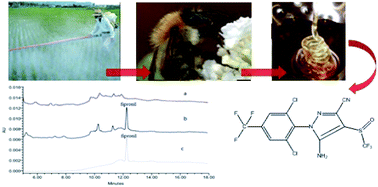Two methods, based on dispersive liquid–liquid microextraction (DLLME) and Quick, Easy, Cheap, Effective, Rugged, and Safe (QuEChERS), have been developed, validated and critically compared in order to analyze the insecticide fipronil in honey by high performance liquid chromatography coupled with diode array detection. Parameters that affect the extraction have been investigated for both methods. In optimal conditions, the limits of quantification were 0.03 and 0.6 mg kg−1 for DLLME and modified QuEChERS, respectively. The relative recoveries were between 70.7–101.1% and 76.3–87.7% for DLLME and QuEChERS, with relative standard deviations in the range of 7.1–11.2% and 5.9–10.8%, respectively. Both methods were found to be simple, fast and inexpensive. By comparison with the modified QuEChERS, the advantages of the DLLME technique were the preconcentration factor and the lower amount of solvent. However, the modified QuEChERS method was demonstrated to be more robust and more suitable for the determination of pesticides in complex samples.

You have access to this article
 Please wait while we load your content...
Something went wrong. Try again?
Please wait while we load your content...
Something went wrong. Try again?


 Please wait while we load your content...
Please wait while we load your content...